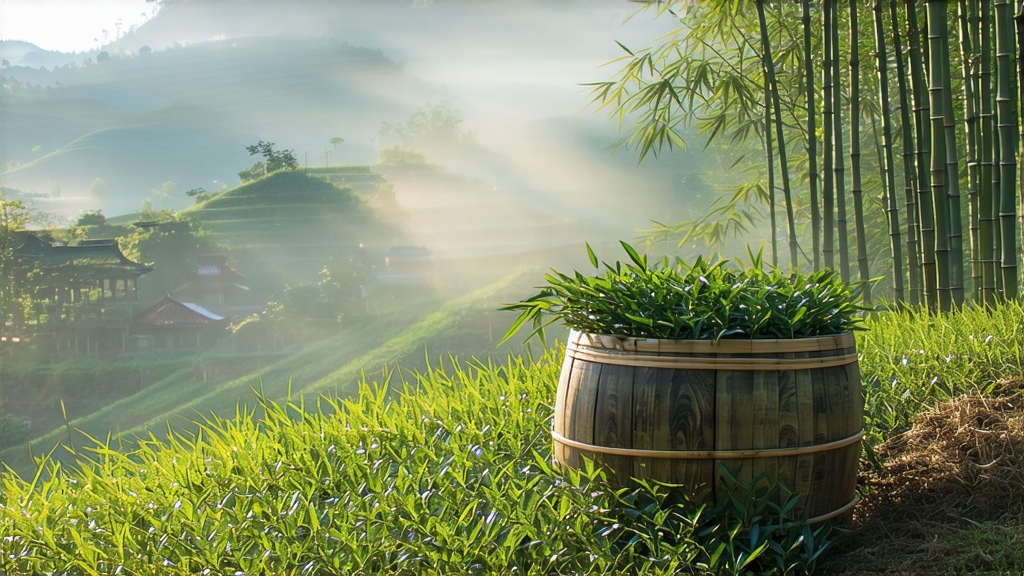
Meng Ding Huang Ya, literally “the yellow bud from Meng Ding,” is one of the most elusive treasures in the six-family Chinese tea spectrum. Nestled on the wind-scoured shoulders of Mt. Meng in Sichuan’s Ya’an prefecture, this bud-grade yellow tea once traveled in bamboo tubes lacquered with tung oil, escorted by horseback relay stations all the way to the Forbidden City. Today it is still picked only between the Qingming and Grain Rain solar terms, when morning mist lingers like silk and the mountain’s perennial cloud cover forces the tea bushes to manufacture extra theanine in near-darkness. The result is a liquor that tastes like warm apricot skin drifting across a limestone spring—soft, mineral, and quietly insistent on your attention.
History: from altar to exile
Buddhist monks planted the first tea gardens on Meng Ding during the Tang dynasty (618-907 CE) to supply the nearby imperial altar of heaven. When Song emperor Huizong—himself a gifted tea connoisseur—proclaimed in 1107 that “mengding is the foremost tea under heaven,” the mountain became a state-protected garden. Tribute quotas swelled to 400 dan (24 tonnes) annually, and every leaf was graded by the “three lights” rule: it had to reflect moonlight on the bush, dawn light on the pluckers’ palm, and lamplight on the sorting table. After the 17th-century transition from compressed tea to loose-leaf, yellow teas fell out of fashion; green tea travelled faster and sold cheaper. Meng Ding Huang Ya survived only because local literati kept a few bushes in their private courtyards, using the leaves as ink-wash inspiration rather than commodity. When the Chengdu-Kunming railway opened in 1970, a retired professor carried 200 grams of seed-stock to the Sichuan Academy of Agricultural Sciences, restarting commercial production with fewer than three kilograms of finished tea in the first year. Today the entire harvest is still under three tonnes, making it rarer per capita than saffron.
Micro-terroir: where clouds taste like stone
Mt. Meng sits at the collision of the Sichuan basin and the Tibetan plateau. In April the temperature swings 15 °C between night and day, forcing the buds to contract and expand twice every 24 hours. The soil is a crumbly phyllite that flakes off the mountain like fish scales; its high quartz content refracts weak sunlight back into the understory, giving the leaves a pale jade undertone. Because the mountain is often above the cloud base but below the snow line, the bushes absorb moisture through their stomata even when rainfall is zero. Local pickers insist that the true “yellow bud” can only come from three micro-gullies—Qingfeng, Ganlu, and Panlong—where wild osmanthus trees drop their flowers just as the tea buds reach fullness, adding an ambient floral microbiome to the leaf surface.
Plucking code: one bud, one ant, one dew
The harvest ritual is stricter than for any other yellow tea. Each plucker carries a cedar stick dipped in honey; if an ant crawls onto the stick, work stops because the insects know better than humans when dew-balance is perfect. Only buds whose spine still holds a spherical dewdrop—what locals call “the pearl that refuses to fall”—are snapped with the thumbnail, never twisted. A full day’s yield for an experienced picker is 300 grams fresh, which shrinks to 60 grams after the yellow smothering process. Every basket is covered with a square of indigo cloth printed with the Meng Ding star map; the cloth is said to “tell the buds they are still under heaven” during the downhill trek.
Craft: the slow suffocation that creates sweetness
Yellow tea’s defining step is “smothering” (men huang), a controlled re-absorption of moisture that edges the leaf toward oxidation without ever crossing the black-tea threshold. Meng Ding Huang Ya undergoes three rounds of smothering, each cooler and longer than the last.
- Sha-qing (kill-green) is done in a wok heated to 140 °C for 90 seconds—just long enough to inactivate polyphenol oxidase while keeping the bud intact.
- First smothering: the warm leaves are piled 5 cm deep inside a bamboo tray lined with wet hemp paper. Over 70 minutes the core temperature drifts from 55 °C to 38